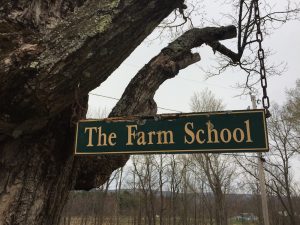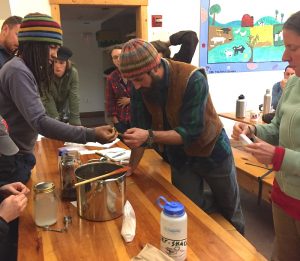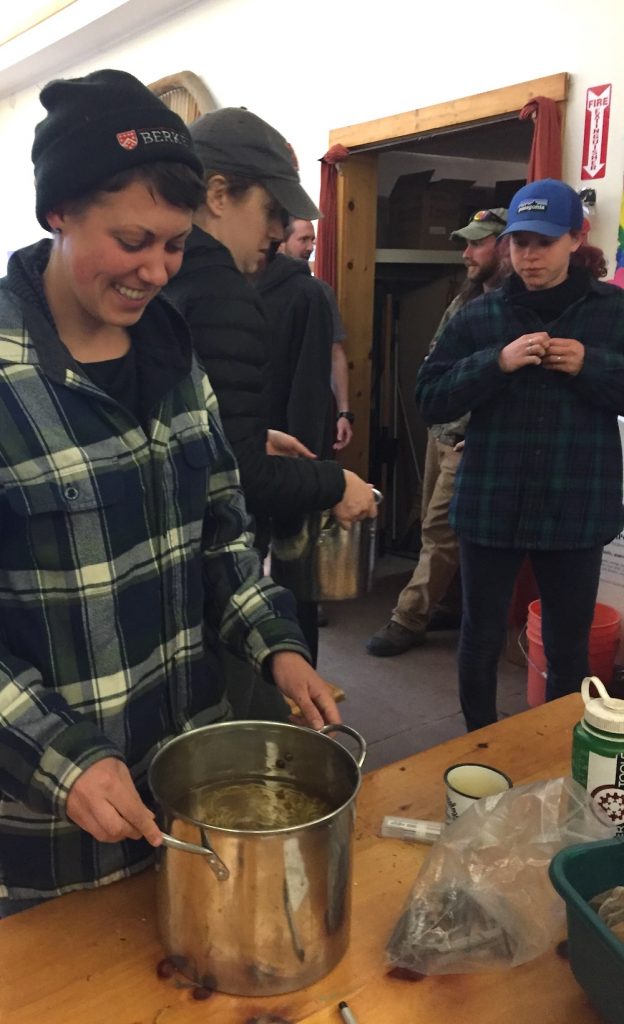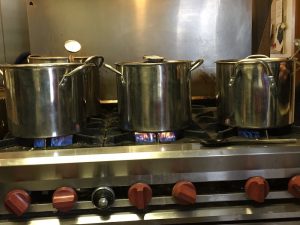One of the fun things I got to do last week was to visit the Farm School in Athol, MA, and to lead a natural dyeing workshop for the participants in their adult farming program. The Farm School combines two of my favorite things: agriculture and education. I had never visited their farm before, so I was thrilled to have the opportunity to be there and to get a better understanding of their different programs. I was greeted by this cheery sign when I first arrived:
Well, actually, when I first pulled up I was greeted by large, white goats browsing the brambles along the side of the road. The goats were accompanied by some friendly humans with welcoming smiles, so I knew I was in the right place. But at that point I was keeping both hands on the wheel and was driving very cautiously. I did not try to snap photos, since goats can be unpredictable! In reality I took this photo on my way out, once the coast was clear.
After a helpful orientation, I was invited to a delicious lunch of spicy daal with the adult student farmers with whom I would be working that afternoon. The food was very yummy and much appreciated! And in case it wasn’t spicy enough, there was a bottle of Sriracha to squirt on top. That’s my kind of meal.
After lunch, we jumped right into the dyeing process. There were roughly 15 students, and the goal was to run a hands-on workshop in which everyone could directly participate. We ran five different dyebaths or vats, in order to offer a range of colors and techniques. We used dried weld to make a bright yellow, dried marigolds to make a golden yellow, an umbilicate lichen vat for a purplish-magenta shade, chopped madder roots for a brick-red, and natural indigo powder for blue.
Students divided into teams of three to make and monitor each dyebath. We used the Farm School’s own wool for this workshop from their flock of primarily Border Leicester sheep, which were sheared earlier this season. The fleeces were spun into skeins at Green Mountain Spinnery in Putney, VT, and were mordanted with aluminum sulfate by Stephanie Cook, who organized this whole lovely experience.
Here is a photo of some of the students testing the pH of a dyebath using pH test strips:
Students also mixed and tested a solution of soda ash that we used as a pH modifier. The pH of a dyebath (how acidic or alkaline the bath is) can make a big difference in the colors that are obtained. Weld and madder also benefit from the addition of calcium carbonate (chalk) to enrich the color, so we used it for both of those baths.
Indigo vats are particularly tricky. For making blue, I usually use fresh plant material during the summer and fall months. For many years I have used woad, and more recently, have used Japanese indigo a couple times. I am very confident with those methods, but I was a little anxious about the indigo vat. While I have certainly run indigo vats before, they can be fussy and we were on a limited time table. Luckily, it worked out fine.
The team that set up the indigo vat wore gloves to handle some of the ingredients. In the interest of time, we used a quickie chemical vat rather than a natural fermentation vat. We used lye and thiourea dioxide to make the stock solution. The indigo powder and Thiox were from Long Ridge Farm in Westmoreland, NH.
Here’s the indigo station. The deep blue skein in the tub on the right is what we dyed that afternoon:
Here is a happy dyer contemplating the prospect of brightly colored yarn:
Here is a shot of students watching the stove:
Each team was responsible for monitoring the temperature of their dyebath and timing how long the dyeplant or the yarn was in the pot. This photo reminds me of the proverb, “A watched pot never boils.” I actually think that this adage is meant to remind dyers that you have to watch your dyebaths to make sure they don’t get too hot. When you are dealing with natural dye materials that are temperature sensitive, such as madder and umbilicate lichen, it is important to make sure that your pot never boils.
Here is a shot of the stove in the kitchen where we were working. I have never run a workshop where we had access to an industrial gas stove, and it was quite a thrill! Six burners could run simultaneously:
I am a proponent of a long soak (overnight or more) and a delayed rinse (allowing the fiber to dry before rinsing) when using plant-based dyes. So, with the exception of the indigo-dyed skein, we transferred all the skeins and dyebaths to five gallon buckets at the end of the workshop so they could absorb more color before rinsing. The colors looked rich and promising by the end of the afternoon, and I hope the skeins turned out well. I certainly enjoyed my time there, and was grateful for the opportunity to meet this energetic and creative group of farmers!






